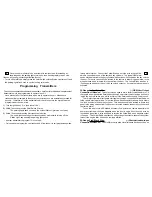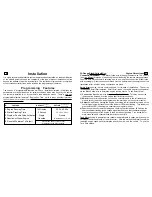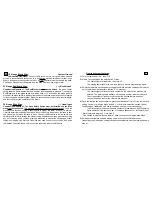
Connect the Green wire to the vehicle's Starter wire. This wire
will show +12 Volts only when the ignition key is in the "Start" position. This wire is also
found in the ignition switch wiring harness. Some vehicles have a second Starter wire
known as a "Cold Start" wire. When this is encountered, two options are available: program
the Yellow/Green wire as a second starter output, or use an optional relay configured to
12-Gauge Green Wire:
Starter Output
Connection Required.
Wiring Connections - 6 Wire Main Harness
(Two 12-Gauge) Red Wires:
Co12 Volts Input
Connection Required.
Connect both Red wires to constant 12 Volts. The source used
must supply adequate amperage. The most common sources are the battery (+) terminal
or the ignition switch wiring harness. Good reliable connections and use of the included
fuses are a must. Note that some ignition switches have the electrical switch as part of the
mechanical switch; others have the electrical switch lower on the steering column and
connected to the mechanical switch by a linkage. The ignition switch wiring harness is the
best source for these wires, and the Starter, Ignition #1 and Accessory wiring connections.
Receiver Module:
The unit has a plug-in window mount Receiver Module. Optimum performance is
obtained by mounting this module high and unobstructed on the vehicle’s glass, such as
the windshield behind the rearview mirror. Make sure the glass surface is clean and free
of dust, grease, or debris. Peel the backing off of the adhesive tape and affix the Receiver
Module. Carefully route the receiver’s 3-wire ribbon cable to the control module; plug the
cable into the Black 3-pin port on the rear of the module
mined which control module wires will be used. Most installers will list these
wires, then "map out" the installation by locating and noting the target wires in
the vehicle. This will also determine the best location for the unit’s control module,
which is mounted upon completion of the installation.
The remote starting unit duplicates the actions that occur within the ignition switch
when you use your key to start the engine. Because of this, most of the main wiring
harness connections will be made at the ignition switch harness. The ignition switch wires
usually are high amperage circuits, which means that high reliability connections must be
made- soldering of all connections is recommended.
Caution!
Avoid the Airbag circuit! Especially avoid any harness or wires encased in Yel-
low or Red tubing or sleeves. Do not use a standard test light, as it can deploy an airbag or
damage on-board computers and sensors.
Main Module:
The Main Module should be mounted in a location close to the ignition switch (where
many of the wiring connections are made); typically, hidden behind the driver’s side
dash.
Valet Switch and Status Light:
Carefully select locations in which the Valet Switch may be easily reached, and the Status
Light may be easily seen, by the driver. Both locations will need clear space behind the
panel. Drill a 15/64” hole for the Status Light, and a 17/64” hole for the Valet Switch. Mount
these items and carefully route their wires to the Main Module.
16
13
































